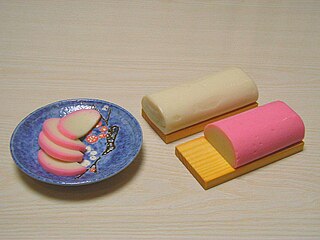 W
WSurimi is a paste made from fish or other meat. The term can also refer to a number of East Asian foods that use that paste as their primary ingredient. It is available in many shapes, forms, and textures, and is often used to mimic the texture and color of the meat of lobster, crab, grilled Japanese eel or shellfish.
 W
WChikuwa (竹輪) is a Japanese fishcake product made from ingredients such as fish surimi, salt, sugar, starch, monosodium glutamate and egg white. After mixing them well, they are wrapped around a bamboo or metal stick and steamed or broiled. The word chikuwa comes from the shape when it is sliced.
 W
WCrab Rangoon, sometimes called crab puffs, crab rangoon puffs, or cheese wontons, are filled crisp dumpling appetizers served primarily in American Chinese restaurants.
 W
WCrab sticks, krab sticks, imitation crab meat or seafood sticks are a type of seafood made of starch and finely pulverized white fish (surimi) that has been shaped and cured to resemble the leg meat of snow crab or Japanese spider crab. It is a product that uses fish meat to imitate shellfish meat.
 W
WFish balls are rounded meat balls made from fish paste which are then boiled or deep fried. Similar in composition to fishcake, fish balls are often made from fish mince or surimi, salt, and a culinary binder such as tapioca flour, corn, or potato starch.
 W
WGyoniju soseji (魚肉ソーセージ) is a Japanese fish sausage made from surimi. It is sold in a plastic casing as a snack. Gyoniku soseji is similar to the traditional fish cake, kamaboko. Gyoniku soseji and kamaboko together constitute 26% of Japanese fish consumption.
 W
WHanpen is a white, square, triangle or round surimi product with a soft, mild taste. It is believed to have been invented during the Edo period in Japan by a chef, Hanpei (半平) of Suruga, and the dish is named after him. Another theory suggests that because it is triangle shaped and appears to have been cut in half from a square, it is a half piece . It can be eaten as an ingredient in oden or soup. It can also be fried or broiled.
 W
WKamaboko (蒲鉾:かまぼこ) is a type of cured surimi, a processed seafood product common in Japanese cuisine.
 W
WNarutomaki (鳴門巻き/なると巻き) or naruto (ナルト/なると) is a type of kamaboko, or cured fish surimi produced in Japan. Each cloud-shaped slice of naruto has a pink or red spiral pattern, which is meant to resemble the Naruto whirlpools in the Naruto Strait between Awaji Island and Naruto, Tokushima Prefecture on Shikoku Island in Japan. The word is also used as a slang term for the at sign "@". It is represented by the emoji 🍥.
 W
WPempek, mpek-mpek or empek-empek is a savoury Indonesian fishcake delicacy, made of fish and tapioca, from Palembang, South Sumatera, Indonesia. Pempek is served with rich sweet and sour sauce called kuah cuka or kuah cuko, or just "cuko". Sometimes local people also eat the dish with yellow noodles and diced up cucumber to balance out the vinegar's sourness.
 W
WSatsuma-age (薩摩揚げ) is a fried fishcake originating from Kagoshima, Japan. Surimi and flour is mixed to make a compact paste that is solidified through frying. It is a specialty of the Satsuma region. It is known by a variety of regional names throughout Japan.
 W
WTsukune (つくね、捏、捏ね) is a Japanese chicken meatball most often cooked yakitori style and sometimes covered in a sweet soy or yakitori tare, which is often mistaken for teriyaki sauce.